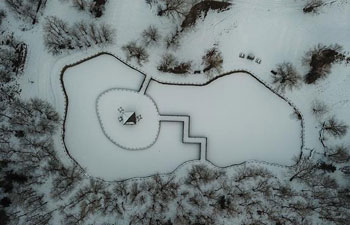by Keren Setton
JERUSALEM, Feb. 5 (Xinhua) -- You are walking down a crowded street. Packed with people, certain faces pop out and others blend in. Who do you notice? And why did you pick out one face and not the other?
In a study recently published in the medical journal "Nature Human Behavior," the conclusion was that dominant and threatening traits are what your brain will register first in similar situations.
The study was conducted by Professor Ran Hassin, a member of the psychology department at the Hebrew University in Jerusalem (HUJI) together with HUJI graduate student Yaniv Abir.
Up to 174 people participated in a set of experiments. In the sterile lab setting, they sat in front of computers with special glasses and were given 300 sets of rapidly changing images.
"We gave the unconscious a very large variety of faces and we simply let the unconscious do what it does," Hassin explained to Xinhua.
Under the geometrical shapes that were rapidly changing on the screen were varying images of human faces. When a participant recognized a face, they were asked to press a key on the keyboard in front of them.
The observation made by him, Abir and other members of the research team was that the facial dimensions that brought a quicker result, in the lab a quicker stroke on the keyboard, were dimensions that signified power and dominance.
"Faces that have wider jaws, more protruding eyebrows, bigger faces, wider faces with stronger facial features ... We can tell immediately, very, very quickly who is dominant or threatening face and who has a more amenable and friendly face," Abir told Xinhua.
The findings are of course those under a sterile lab setting. However, it was clear to the team that different settings lead our unconscious mind to bring forward different types of faces.
Going into a bar looking for a date, you will seek different faces.
"The dimension that you would see in a threatening environment, would not be the same dimension you would see in a very socially relaxed environment. It would be different," Hassin said.
Using a computational method and algorithms, the experiment is basically an attempt to map the algorithms within the human mind.
A peek into our unconsciousness may lead to wider applications and breakthroughs in the treatment of several mental conditions.
"If this dimension is functional, which we believe it is, then it gives you things to work with," said Hassin. "If the cognitive system can change it according to your goals and motivations, maybe we can do it too."
Abir and Hassin have autism, post-traumatic stress disorder and depression in mind for much later phases of their research.
"People in depression ... tend to see sad faces around them more than people who are not depressed," Hassin said.
"If you can change that dimension a little bit, make them see a more smiley world, then it might work too," he added.
For autism, Hassin and his team believe that it may be possible to train the unconscious mind to understand social cues which many people living with autism have difficulty doing.
The aim is "to change what they become conscious of naturally, spontaneously" said Hassin, so "it might help them function in a better way."
Although the research is just at the beginning stages, the team seems hopeful.

















